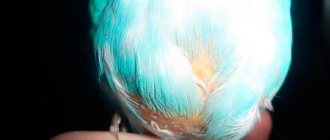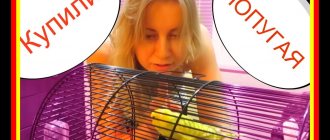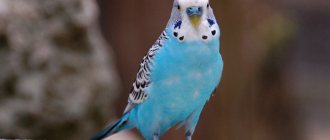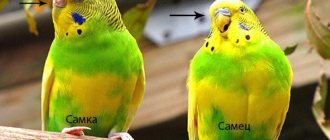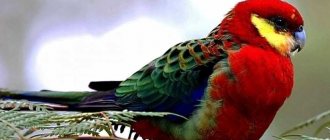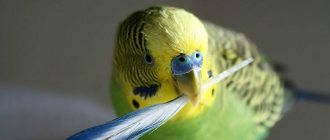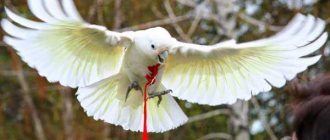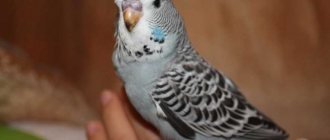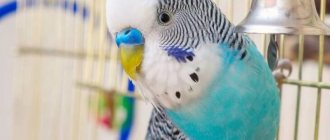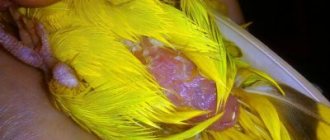Maintenance and care
The maintenance of ordinary and exhibition budgerigars will not differ significantly. But it is worth noting that the Czechs are more unpretentious. Mandatory conditions for their comfort look like this:
- a warm room without drafts;
- temperature not less than 23°C;
- daylight hours from 10 to 13 hours;
- suitable air humidity;
- frequent bathing (at least once a week);
- friendly atmosphere.
If you can’t devote enough time to communicating with your parrot, you should get 2 or more birds at once.
Particular attention should be paid to the cage and nutrition
Arrangement of the cage
The cage should have dimensions of 30x40x50 cm. These are the minimum indicators designed for one parrot. The ideal option is an aviary. Especially if you have several pets at once.
If the size allows, inside the cage you can put perches, a couple of feeders, toys, and a house for breeding offspring.
In cramped cages, the risk of developing infectious diseases increases. And Czechs, due to frequent crossings, have weak immunity. To prevent them, you need space and cleanliness. It is better to clean the cage 2 times a day, morning and evening. All containers must be disinfected.
Diet
As stated above, there should be 2 or even 3 feeders in the cage. The first is needed for grain, the second - for mineral feed, the third - for vegetables and fruits. The latter, by the way, can be hung on the bars of the cage using special holders.
Grain mixtures should make up the majority of the diet
Particular attention should be paid to those based on millet. You can supplement them with flax seeds, oats and wheat.
To prevent obesity, a maximum of 1 tsp can be given per feeding. grains.
What else to feed Czechs:
Diet
The diet of ordinary wavy fish and Czech fish is not very different. The main share of the diet comes from an industrial grain mixture, 50% of which is millet of different varieties. In addition to this, you need to give your parrot fruits, vegetables, and herbs every day. Once a week, pamper your pet with a boiled egg and cottage cheese. Vitamin and mineral supplements should be freely available, especially during the molting or breeding period. You can also hang sepia and chalk in the checkered pattern.
Feed and water are changed for the bird twice a day. Czechs are prone to digestive disorders, so they need to introduce new foods into their diet slowly and gradually. Greens and fruits should be washed well, it is even better to pour boiling water over them before serving. You should not offer show wavy animals fatty foods: sunflower seeds, nuts. Bread, sweet, fried or salty foods from the human table are also prohibited.
Education, training, games
The bird cannot be alone; it needs to constantly find something to do.
In the absence of household members, he will entertain himself with the offered toys that are in the cage. To prevent the parrot from getting bored, hang a mirror in a safe frame.
A pet can be taught not only words, but also various tricks and games. He will immediately understand what is required of him when they offer to play hide and seek, catch a ball, or tug of war.
The wavy Czech will carefully watch how a person assembles and disassembles the pyramid and will be able to assemble it according to the same principle. Particularly persistent bird owners teach them how to add dominoes on an abacus. A bird must have only one teacher, otherwise the bird will get confused. Classes are initially given for 15 minutes, then the time is increased to 20, 30 and 40 minutes a day.
Bathing and hygiene
Water treatments are recommended for Czech parrots once a week. It is better to purchase a special bathing suit for birds. Due to their poor health, these birds are more demanding of their living conditions. To prevent your pet from getting sick, you need to clean the cage twice a day and disinfect it weekly.
Exhibition budgerigar (CZECH) nursery king-parrot.ru
Subtleties of maintenance and care
It would seem that such a regal bird requires special conditions of detention. However, Czechs are quite unpretentious. The same environment in which budgerigars live is quite suitable for them:
- no drafts, warm room (at least 23 ºC);
- daylight hours 10 – 13 hours;
- humidified air, regular bathing;
- calm environment.
A lonely parrot needs human attention. Be prepared to spend a lot of time interacting with your pet.
Czechs have a hard time with separation, so ornithologists recommend keeping two or more birds together, especially if they are already accustomed to each other. The established company should not be divided, otherwise it will greatly affect the health of the wards.
Cell
To house a flock of Czechs, you need a spacious cage, or even better, an aviary. The size of the future home is limited only by the area of the room that you are willing to allocate to your pets. The minimum cage dimensions for one parrot are 30/40/50 cm, which is slightly larger than for an ordinary wavy. If the cage is spacious enough, you can place wooden perches, two or three feeders, play accessories and even a nesting house inside it. It will be needed when the birds begin to prepare for breeding.
Czech budgerigars are not very healthy, which means that they need careful preventative care. When birds are kept closely together, the likelihood of infectious diseases increases. To avoid infection, you need to monitor the cleanliness of the cage, equipment, the quality of food and water, and also disinfect containers.
Diet
The concept of “good care” for Czechs also includes proper nutrition. Purebred parrots are given regular dry food, fresh fruits, and boiled vegetables. Seeds and crushed grains are suitable for food:
- millet;
- oats;
- canary seed;
- wheat.
Birds need mineral mixtures and vitamins because they do not get enough of them into the body through food. Breeders recommend fortified assorted grains, which already contain vitamins and microelements.
Attention! Balanced food helps maintain the health and beauty of the bird's appearance: clear eyes, dense plumage, strong beak and claws.
The nutrition of show parrots requires a special approach: although they are small species, they require more food
And here it is important to observe moderation, because Czechs are prone to obesity, and this is a direct path to decreased mobility and the appearance of diseases. To protect your original pet, you need to give him no more than 1 teaspoon of grains per meal
Choosing the best place
Illumination
The place where the bird's house is located should be well lit. However, you should not place the cage on a windowsill under constant exposure to direct sunlight.
The length of daylight hours is extremely important for the health and proper rest of your feathered friend. In the summer it should be about 15 hours, by winter it should gradually be reduced to 10. If a chandelier is burning in the room long after dusk or the TV is on, the cage with the pet should be covered with a thick cloth to ensure peace. If there is insufficient lighting, a blue light UV lamp is installed next to it.
Temperature and humidity
Dry air is often found in winter when heating appliances are running. The optimal level for keeping a pet is considered to be 50-60%. To moisturize, you can use a spray bottle, a wet cloth, or special electrical appliances. The parrot's cage should not be placed next to the battery.
It is necessary to maintain the correct temperature and humidity
Comfortable ambient temperature for a pet is 20-25 degrees. A reading below 18 is dangerous for birds.
Avoiding drafts
Drafts and cold air should not be allowed in the Czech room. This breed of bird has poor health and is more susceptible to colds than other bird species.
Cage and additional accessories
The optimal size of a bird house is 60x40x80cm, the minimum acceptable is 50x40x35cm. The distance between the rods should be no more than 1.5-2 cm so that the pet cannot stick its head between them.
Inside you need to place 2-3 wooden perches, an automatic drinker, and three feeders for different types of food. The bird is inquisitive and active, so it needs toys for leisure. It could be a rope, a ball, a ladder, a swing. It will be very good if you can install a special stand next to the cage in the form of a wall bars, where she can climb and occupy herself.
Understanding what kind of cage to get for a parrot and how to fill it
How to choose a home for a parrot
There are some requirements for the size, shape and arrangement of a bird’s home.
Dimensions and shape
The optimal cage size for one Czech is at least 50/40/30 cm. It is better if it is made of metal (but not copper). Wooden dwellings are undesirable for parrots.
The shape of the cell can be different. Typically, budgerigars are kept in rectangular metal houses with a dome-shaped top.
Did you know? According to the Guinness Book of Records, the smartest parrot in the world is considered to be a representative of the Gray Gray breed named Alex. He died in 2007. During his lifetime he could pronounce about 400 words, spoke in sentences, and was able to solve simple mathematical problems.
Arrangement of the cage
Cage perches must be purchased with a diameter of at least 2.5 cm
It is important that they are made of wood, since plastic ones are not very comfortable for birds and can injure them. You will need two or three of them
It is necessary to install a tray at the bottom and a net above it so that the bird does not eat the fallen food. It is also desirable to have a retractable bottom that is easy to clean.
The Czech cage should be equipped with three feeders. One is intended for grain, the other for a mineral mixture, the third for vegetables, fruits, cereals, and sprouted wheat.
To prevent the bird from getting bored, you need to equip a play corner in the cage, placing two or three different swings and toys in it.
Important! The main thing with toys is not to overdo it: they must be selected depending on the size of the cage. After installing them, the bird should still have plenty of space to move. It is necessary that all objects are located in places convenient for the bird and do not interfere with it
Examples of successful cage equipment for parrots can be found on the Internet.
It is necessary that all objects are located in places convenient for the bird and do not interfere with it. Examples of successful cage equipment for parrots can be found on the Internet.
If the size of the cage allows, it would be good to purchase a bathing container for the bird.
Caring for a Czech parrot
Unlike most artificially bred species, these crested birds are unpretentious. They do not require specific nutrition or special handling. Compared to individuals of the wavy species, Czechs quickly memorize human speech and can not only recognize the owner by voice, but also repeat frequently heard words. Depending on how long Czech parrots live in a family, their vocabulary expands.
The first time after moving to a new home, the bird behaves warily and somewhat constrained. She gets used to new people and unfamiliar surroundings, so she may show detachment and reluctance to communicate. It's quite normal. As soon as the bird gets used to the changes, it will enter its usual rhythm of life. At this time, proper care of the Czech parrot is especially important. First of all, feeding the foods that the pet is accustomed to. A balanced diet for a bird consists of special food, including different types of cereals, fruits, vegetables and sprouted grains. Birds are given vitamins and mineral supplements as food.
The care and maintenance of Czech parrots also includes taking care of the comfort of the bird’s home.
It is important not only to choose a cage of the appropriate size, but also to equip it with devices for feeding and playing with the bird. The mandatory “furniture” of the cage includes several food bowls, drinking bowls, a ladder and a mirror.
If your bird will be living without a partner, she will need as many toys as possible to keep her busy and occupied while you are away. How long your Czech parrot will live depends on its psychological state, so it is important for you to take care of its leisure time. And if possible, place a relative in his cage.
Education and training
The Czech parrot is well trained to talk and do tricks. But you need to exercise regularly, otherwise he will become sad and may get sick. Play time with a feathered friend should be at least 30-40 minutes. And in order for your pet to make progress in imitating human speech, it is necessary to conduct at least 20-minute lessons every day. Don’t forget to praise your little student and encourage him with treats, then his full potential will be revealed.
History of the appearance of the Czech parrot, description
The Czech parrot was bred in England in the middle of the last century. It happened by accident. One of the breeders noticed an unusual offspring from a pair of budgerigars. Parrots differed from their relatives in size, skull structure, wing position, etc.
The British liked the unique birds so much that they created a club dedicated to their conservation and selection. The Germans began to produce a variety of plumage colors. This is how green, yellow, blue and even purple Czech budgies appeared.
Czech wavy plants were brought to the territory of the USSR from Czechoslovakia in the 80s. Hence the name. In 2011, the first exhibitions were held in Russia.
Interestingly, in Europe Czechs are called show budgerigars (SBP). This is one of the most expensive breeds. But at the same time, it is less popular than others.
Adult Czech budgies reach a size of 23-28 cm. They have a bright solid or combined color. Brightness is considered a characteristic of the breed.
It is worth mentioning the existence of the half-booth parrot. It has the same size, but does not boast bright plumage.
Chicks are not much different from ordinary budgies. And only after the first molt noticeable features appear. This is fluff on the crown (“cap”) and a bright beard under the beak.
Exhibition parrots are characterized by the following external characteristics:
- broad shoulders, massive but short neck;
- protruding chest, straight posture;
- long tail with two tail feathers;
- straight, strong legs;
- uniform color of the front part of the head.
Another feature of this type of parrot is the “beads”. They consist of bright round spots symmetrically located on the beard.
Fixed ring and price
An ordinary budgie can be bought at any pet store without any documents or a ring. After all, they are bought for their own pleasure, and not for an exhibition career.
Anyone who wants to purchase a real show Czech budgie needs to know that the purchase can only be made from a breeder. And only one that is officially registered in the “Russian Club”. In this case, he has a personal unique number and the opportunity to order permanent rings for his feathered charges. Each ring has:
- a certain color according to the age of the bird;
- year of birth;
- unique breeder number;
- serial number of the chick;
- club data.
Somewhere on the poultry market they can sell a Czech without a ring, which means there is a complete lack of guarantee in determining the age and origin of the bird. Unscrupulous sellers may sell an old bird instead of a young one. Also, without a ring, there will be no way to register a pedigree for a Czech parrot and, accordingly, to take part in an exhibition.
In addition to Czechs, there are other types of budgerigars in the world. Since there are too many of them, we have highlighted the main and most interesting varieties.
Appearance of a Czech parrot
Czech is the same budgerigar, only slightly “tuned”. The British achieved some success in this - they gradually increased the size of the bird. First, the parrot became longer, then wider, and later the rest of the body was adjusted to these dimensions so that the bird looked harmonious.
German breeders focused on demonstrating their bright individuality, providing the birds with a beautiful, rich color scheme. An ordinary budgerigar can be easily found in every pet store, but its Czech counterpart can only be purchased from breeders.
Officially registered nurseries order special foot rings for their birds, which are not removable, and which can be used to determine the bird’s age, serial number and club data.
Such birds are very similar to ordinary parrots in the combination of colors in their feathers, the shape of their wings and tail, but the Czech still has several noticeable differences. The first thing that catches your eye when comparing a Czech and an ordinary budgie is the size. Czechs are noticeably larger due not only to their actual size (about 10 cm larger than a wavy), but also due to their increased fluffiness.
In the photo there is a Czech parrot and an ordinary budgie
Such birds even look somehow courageous. Of course, they do not reach the size of large birds, but among their wavy counterparts they stand out in size. Among the Czech budgies, there are also several types of appearance - the larger and fluffier the bird, the longer the feathers on its cheeks, the more purebred, high-quality, and expensive it is.
The second difference is that the Czech has a cap on his head. This luxurious decoration appears on the bird when it moults for the first time. The feathers on the head puff up in the shape of a cap, and on the cheeks they are long and have black spots, which, reaching to the neck, create the illusion that the bird is wearing beads.
In the photo there is a feather cap, characteristic of Czech parrots
Even baby Czechs can already be distinguished from an ordinary budgie. The brightness of the Czech plumage is also a sign of the breed. There are birds of large size, but not brightly colored - these are half-Czechs.
The main differences between a parrot and an ordinary budgie
Czechs have a number of similarities with ordinary wavy cats. But it is precisely these differences that give them a majestic, dignified appearance, for which the bird was so loved by breeders at one time.
The main differences between the Czech parrot and the budgerigar
Let's consider the main signs of dissimilarity:
Size
This is the first thing that catches your eye when comparing two related birds. Czech is one and a half times larger than a regular wavy.
Posture
Thanks to its long keel, the bird always seems to maintain its posture, which gives it a stately, aristocratic appearance.
Wing position
The Czech budgerigar does not cross its wings behind its back, as budgerigars do, but neatly fold it on its sides.
Head
The massive head of the courageous bird is decorated with a lush crown or cap of feathers.
Beads
The brisket has bright, large, round spots called beads. There are usually at least six of them. In budgies they are small and weakly expressed.
One of the differences is the beads on the parrot's neck
Character
It is believed that the pets of the described breed are calmer, balanced, and phlegmatic than the mischievous little ones. Although it all depends on the temperament of the individual.
Activity
Due to their massive build, Czechs are less mobile and get tired faster in flight. They do not constantly run around, like their restless brothers, but walk around importantly, studying the surrounding objects.
Health
The beauty and originality of the breed was not easy for the Czechs. Selection of the species had its negative features. Due to numerous inbreeding, the exhibition budgerigar has poor health and reproductive problems.
Czech parrot health
Price
This species is difficult to breed and is demanding in caring for a budgie. This explains the high price of poultry.
Conditions for keeping wavy Czechs
In what conditions should the wavy cover be kept? Firstly, people who have cats at home are not advised to have a bird. No matter how lazy and phlegmatic the cat may be, he is a predator and perceives the parrot as food that one day he can taste.
Unlike cats, budgies need to be occasionally fed oranges, tangerines and apples. Initially, they were fed only fruits, as it was believed that budgies were natural vegetarians, but later people realized that this was not the case.
In their natural habitat, parrots also eat insects, and when living at home they will not refuse protein foods, for example, a boiled egg. But not all whole fruits can be fed to these birds; the seeds of apples, pears and cherries are poisonous to them, and it is also not recommended to give parrots food from the table.
To feed birds, food enriched with vitamins and minerals must be used, otherwise the parrot will start to get sick and all this can end in tears.
It is best to take a spacious cage, with metal bars, but you cannot keep a parrot there all the time; just like a person, he needs to move a lot and stretch his muscles.
Parrot cost
Compared to other bird species, the budgie is inexpensive. These small and talkative birds are not considered extremely rare, because they flooded the CIS countries back in the 60-70s. Back then, wavy animals were extremely popular and were purchased en masse by both exotic lovers and families with children who wanted to get a smart pet.
Today the budgerigar is not wildly popular. The fashion for keeping these talkative individuals has long passed, but the love for them remains. Children and adults perceive wavy dogs as cute, kind and unpretentious pets that can be adopted if there is no time or money for a larger one. On average, a budgie costs from 300 to 700 rubles in pet stores. Individuals with rare colors may be sold at a slightly higher price. The price for them usually does not exceed 2000 rubles.
Diseases and their treatment
Numerous inbreedings during the breeding process affected the health of Czech parrots. They often suffer from colds. Weak immunity makes these birds vulnerable to:
- ectoparasites;
- worms;
- mycoses;
- dysbacteriosis.
The Czech budgie is a very tame budgie.
And, of course, they are more susceptible to bacterial and viral infections.
It is extremely important to implement proper preventive measures in a timely manner. Keep the bird clean and regularly inspect the plumage for insects. Individuals prone to digestive disorders can be given probiotics.
If your pet is sick, it should be immediately shown to an ornithologist. Do not self-medicate, because it is very easy for a non-specialist to make a mistake with the dosage of drugs, which can harm the parrot.
How to distinguish a female from a male budgerigar
- How to determine the gender of a budgerigar by its beak
The cere is a bulbous, fleshy area located where the top of the beak meets the head. Typically, mature males have a dark blue (maybe purple) and smooth cere. It is also more noticeable than the female's. The cere of males is also quite constant in color.
Juvenile males are usually light pink-purple in color. As a rule, adult males with light feathers (white, yellow, albino, lutino) have pink or brown wax color. In this case, it can be difficult to distinguish a female from a male budgerigar. In general, as birds grow older, the male cere becomes darker, while the female's becomes lighter.
An adult female budgerigar has a pinkish-brown, rough cere. It is usually inconsistent in color. A young female may initially have a pink cere, which then turns slightly purplish-bluish-white after 3-4 months and may turn pinkish-brown or pinkish-blue again after 8 months.
Voskovitsa - the upper part of the beak that connects to the head
- Paw color
Male budgerigars may have bluish legs because hormones control the color of their heads and legs.
Female parrots usually have pink or brown colored feet. It is impossible to determine the sex of a budgerigar chick based on this feature, since they all usually have pink paws, regardless of gender. However, some adult male parrots also have pink feet.
- Body Shape
Males are usually larger, stronger, and slightly heavier than female budgies. They have a relatively large head. The feather colors of male parrots are brighter than those of females. All these factors depend on the health of the birds.
The male is usually larger than the female
The male budgerigar has a rounded head, while the female has a slightly flattened head.
- Behavioral differences
Although you shouldn't rely on a behavioral pattern to tell a female from a male parrot, after careful observation you can learn the difference between the two and understand how to differentiate budgerigars more accurately. Males love to sing and are relatively calm. If you spot a parrot feeding another parrot, it is likely to be a male. Male parrots will give food to other males, but female parrots will only feed their babies.
Females are known to be aggressive and they talk more but sing less. Females bite more often than males.
Females are more aggressive than males
- Laying eggs
Obviously, if a budgie lays eggs, it is female. However, the absence of eggs does not mean that the bird is male. Sometimes females do not lay eggs due to malnutrition, other health problems, old age and other reasons.
- Cheek spots
Males may have dark purple cheek patches, while female parrots are more likely to have light purple patches. However, this may not be an accurate way to tell how to tell the gender of a budgerigar, as often no difference in color is noticeable.
- DNA testing
DNA testing is the only accurate way to determine the sex of a parrot. The test requires a fresh blood sample from the bird. To make the test minimally invasive, it is performed on freshly harvested feathers. Fallen or faded feathers are useless. The instructions of the genetic laboratory must be strictly followed when drawing and sending feathers. Mating budgerigars by blood (only 1-2 drops of blood is required) is less safe, more stressful and less accurate than by feathers.
Freshly collected eggshells can be examined to determine the sex of a budgerigar chick
Freshly collected eggshells containing DNA from a newly hatched chick can be examined to determine the sex of a budgerigar chick that is only a few hours old.
The best way to tell the sex of a budgie, without expensive lab tests or trips to the vet, is the position of the pelvic bones. It's also a relatively simple way to use. If you put your finger under a parrot's tail, you will find what is called a cloaca. The bird releases gas and other excrement from it. Just above this area you can feel two protrusions. These are the pelvic bones of a bird.
Try to examine the position of the pelvic bones
A female parrot's pelvic bones will continue to separate as she matures into adulthood, creating space for the egg-laying process. You can place the tip of a medium-sized finger between the bones.
How does the Czech budgerigar differ from the “ordinary” one?
As you already understand, the well-known small budgies served as the “source material” for breeding the breed that interests us. The main differences between Czech budgies and ordinary ones lie, first of all, in size. These birds are much larger and, so to speak, more massive. At the same time, the bird does not look “overfed” - the proportions of its body are very harmonious (of course, in a “full-fledged” specimen). The second difference is the presence of a pronounced crest and beard. The crest is noticeable even from afar - the bird resembles a kind of pompous “punk” (but more often the crest resembles a shaggy hat; and the bird holds its head proudly, as if it really had a crown or Monomakh’s hat on its head). The beard has a characteristic pattern, which fans call “beads.” The wings of the Czech budgerigar fold on the chest, but do not cross each other.
The next difference lies in the nature of the birds. They are much calmer than ordinary wavy ones. Indeed, when you have a chest like a wheel and a crown on your head, what else should you worry about! According to some reports, it is even easier to teach a Czech budgerigar to speak than an ordinary one. Of course, he will speak, not necessarily in Czech - depending on what language you speak. Some birds learn to speak on their own, without much “coercion” - they simply repeat words from the conversations of those around them, as well as sounds made by pets.
Caring for a Czech Budgerigar
In general, budgies are quite unpretentious birds. Regular feeding and care will ensure a long and healthy life for these beautiful birds. At the same time, “Czechs” live a little less than ordinary parrots, but this difference is very small. They eat almost everything, especially love fruits - oranges, tangerines, apples. They don’t refuse boiled eggs either. For a long time, when scientists just began to study wavy birds in their homeland - Australia, there was an opinion that these birds were exclusively herbivorous. However, then their omnivorous nature was discovered - the birds happily caught and ate insects. So protein food will not harm Czech budgies.
Salty foods, chocolate and, of course, alcohol should not be given from food. You should refrain from giving them food from the table - food for parrots must be specially prepared. If you give him cottage cheese, make sure it is not greasy. It is also very dangerous to give the seeds of apples, pears, and cherries - they contain a substance that is toxic to them.
It is preferable to take a cage for Czech budgerigars from metal, but you cannot use galvanized or aluminum ones. It is forbidden to lay newspaper on the bottom of the cage - it also contains dangerous substances.
The climatic conditions in which budgerigars initially grew made these birds undemanding in terms of air temperature and humidity. They can live in a room where it is quite hot, and where the temperature does not rise above 10 degrees. However, you should not immediately transfer budgies from the “warm” side of the house to the “cold” side, since they do not tolerate such drastic changes well. Also, wavy birds are very afraid of drafts, so if the cage is located near a window and you decide to open the window, then it is better to move the cage at this time. It is very undesirable to smoke in the presence of a budgie: smoke for him is only torment.
One more important note. A parrot cannot be kept in a cage all the time (just like a person)
The bird should be regularly released and allowed to fly around the room - it loves to do this. Gradually, the bird will learn to sit in certain places in the room that it likes. And if so, then you won’t have to run after her around the house.
The calm nature of the bird means that it pollutes the apartment less than other pets. The parrot may scatter small debris, but it can be easily removed with a vacuum cleaner. Any pet leaves its “traces” in the apartment, and if someone really can’t stand dirt, then it’s better not to have anyone.
How to teach a parrot to talk?
If you decide to seriously teach your parrot human language, then remember that classes should be conducted by one person so that the bird is not distracted. The first classes should be up to 15 minutes, later time can be increased to 40 minutes. Say the words repeatedly, slowly and clearly. The first words should contain growling and hissing sounds (as for humans - they are the most difficult to learn). After the bird begins to pronounce the next word, do not forget to thank it and treat it with something tasty. Having learned a certain number of words, you can move on to whole phrases.
Read with this
- Correct Names for Boys and Girls Budgerigars
- Everything you need to know about caring for budgies at home
- How to determine the sex of parrots: budgerigars, cockatiels and others
- How to care for budgies at home?
- All unknown facts about budgies. What's interesting in the world of poultry
- Ruffled parrot
- Let's figure it out
- Making a parrot cage with your own hands
- Login to the site
- Diseases and treatment of parrots
